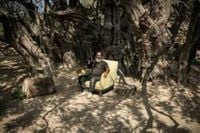In the shadow of the towering Israeli separation wall, Salah Abu Ali, a 52-year-old resident of Al-Walaja, south of Jerusalem, tends to what is believed to be the oldest olive tree in the occupied West Bank. This ancient tree, a living witness to millennia of history, stands as a powerful symbol of Palestinian resilience amid a season marked by violence, drought, and the ever-present weight of conflict.
Abu Ali’s connection to the tree is deeply personal. “This is not an ordinary tree. We are talking about history, about civilization, about a symbol,” he says, his pride evident beneath a thick beard as he surveys the gnarled trunk and sprawling branches. According to experts, the tree’s age is estimated between 3,000 and 5,500 years—a span that encompasses the rise and fall of empires, shifting borders, and countless generations. Through it all, the tree has survived drought and war, its roots anchored in land that has seen more than its fair share of turmoil.
Al-Walaja itself is a microcosm of the Palestinian experience. More than half of the village’s original lands now lie on the far side of the five-meter-high Israeli separation wall, which is topped with barbed wire and cuts through the landscape like a scar. “Today, Al-Walaja embodies nearly all of Israel’s policies in the West Bank—settlement expansion, the wall, home demolitions, land confiscations, and blockades,” explains the village’s mayor, Khader al-Araj, as cited by BGNES and AFP.
Yet, amid these challenges, the ancient olive tree persists. Its trunk measures nearly two meters in diameter, and its dozen massive branches—some named after Abu Ali’s relatives—tower above the more common olive trees that grow to about three meters in height. Around this living monument, Abu Ali has created a small oasis, planting herbs and fruit trees and keeping a guestbook filled with messages in dozens of languages from visitors around the world.
This year’s olive harvest began in mid-October, but it has been anything but peaceful for many Palestinians. The Palestinian Authority’s Commission Against the Wall and Colonization documented a staggering 2,350 settler assaults in October alone. According to AFP, Israeli settlers—part of the 500,000 living in the West Bank—have attacked Palestinian farmers almost daily as they attempt to reach their groves. Almost none of these perpetrators face justice, while Israeli forces frequently disperse Palestinians with tear gas or block their access to their own land.
Remarkably, Al-Walaja has so far been spared the violence that has marred this year’s harvest. Abu Ali continues to care for the tree, undeterred by the dangers that have become routine elsewhere. “It has become a symbol of Palestinian resilience. The olive tree embodies the Palestinian people themselves—rooted in this land for thousands of years,” says Mayor al-Araj, echoing a sentiment that resonates throughout the region.
In a good year, the ancient tree yields between 500 and 600 kilograms of olives—a testament to its vitality and the care it receives. But this year, weak rainfall has led to a poor harvest across the West Bank, even for this venerable specimen. The tree is known by many names: The Elder, the Bedouin Tree, the Mother of Olives. For Abu Ali, its significance goes far beyond its agricultural value. “The oil from this tree is exceptional. The older the tree, the richer the oil,” he says, describing the precious liquid as “green gold.” Its oil is worth four to five times more than that produced by younger trees, a rare delicacy cherished by those who can obtain it.
Tourism once brought crowds of pilgrims and curious travelers to Al-Walaja, eager to witness the majesty of the ancient olive tree. However, since the war in Gaza began in October 2023, visitor numbers have plummeted. Checkpoints across the West Bank have tightened, making access difficult and further isolating communities already under strain.
The hardships faced by Al-Walaja are not new. In 1949, following the establishment of Israel, much of the village’s land was seized, and many Palestinian families were forced to leave their homes and resettle on the other side of the so-called armistice line. The 1967 occupation brought further changes: most of the remaining territory was designated as Area C—under full Israeli control—according to the 1993 Oslo Accords. Area C now constitutes 66% of the West Bank, and homes lacking Israeli building permits are under constant threat of demolition, a common plight for Palestinian communities in the region.
The tree’s official status as a natural monument is a point of pride for Al-Walaja. The Palestinian Ministry of Agriculture has formally recognized it, appointing Abu Ali as its official guardian. He takes this responsibility seriously, nurturing the tree and the land around it, even as the world outside seems to grow more uncertain by the day. “I have become part of this tree. I cannot live without it,” Abu Ali reflects, his words capturing the profound bond between people and place.
Despite the decline in visitors, the tree remains a beacon of hope and continuity. Its branches, some named for loved ones, stretch skyward—a silent testament to endurance and connection. The guestbook at its base tells a story of international solidarity, with messages written in languages from every corner of the globe.
For many Palestinians, the olive tree is more than an agricultural asset. It is a symbol of their rootedness in the land, a living reminder of their history, and a quiet act of resistance against forces that seek to uproot them. As the conflict continues and the future remains uncertain, the tree stands firm, its roots deep in the soil of Al-Walaja, its branches offering shelter, sustenance, and a touch of peace in troubled times.
Through the care of Salah Abu Ali, the ancient olive tree endures—an emblem of resilience in a landscape shaped by hardship, hope, and the unbreakable ties between people and their land.
